Abstract
Cyanobacteria harvest light energy through multimolecular structures, the phycobilisomes, regularly arrayed at the surface of the photosynthetic membranes. Phycobilisomes consist of a central core from which rods radiate. A large polypeptide (LCM, 75-120 kDa) is postulated to act both as terminal energy acceptor and as a linker polypeptide that stabilizes the phycobilisome architecture. We report here the characterization of the gene (apcE) that encodes this LCM polypeptide in Calothrix sp. PCC 7601. It is located upstream from the genes encoding the major components of the phycobilisome core (allophycocyanin) and is part of the same operon. The deduced amino acid sequence shows that the N-terminal region of LCM shares homology with the other phycobiliprotein subunits and thus constitutes the chromoprotein domain. The other part of the molecule is made up of four repeated domains that are highly homologous to the N-terminal regions of the phycocyanin rod linker polypeptides. The predicted secondary structure of the different domains of the LCM is discussed in relation to the different roles and properties of this large molecule.
Full text
PDF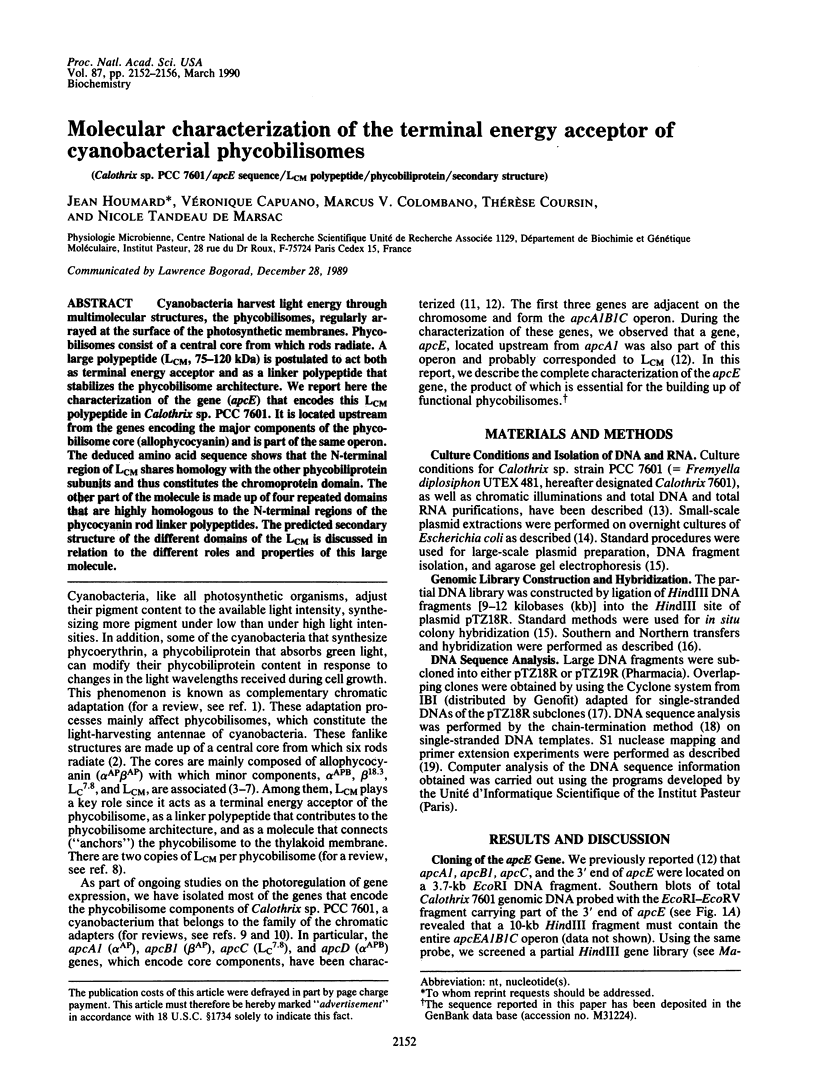
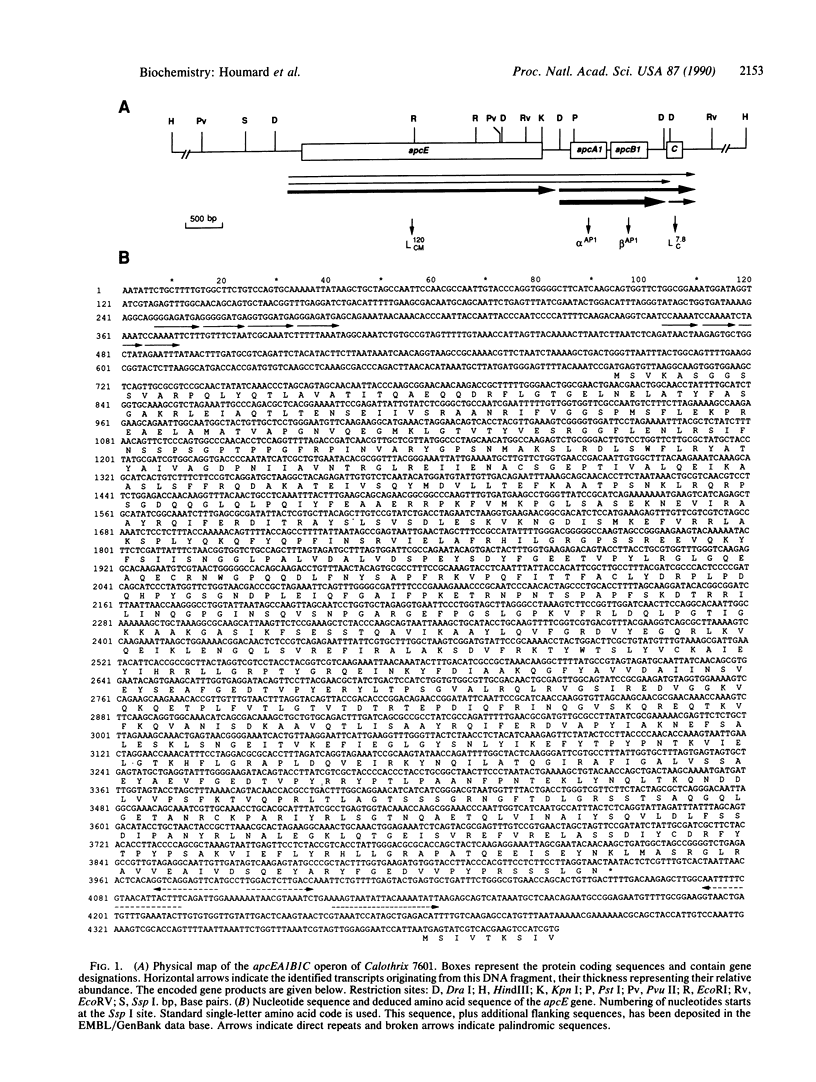
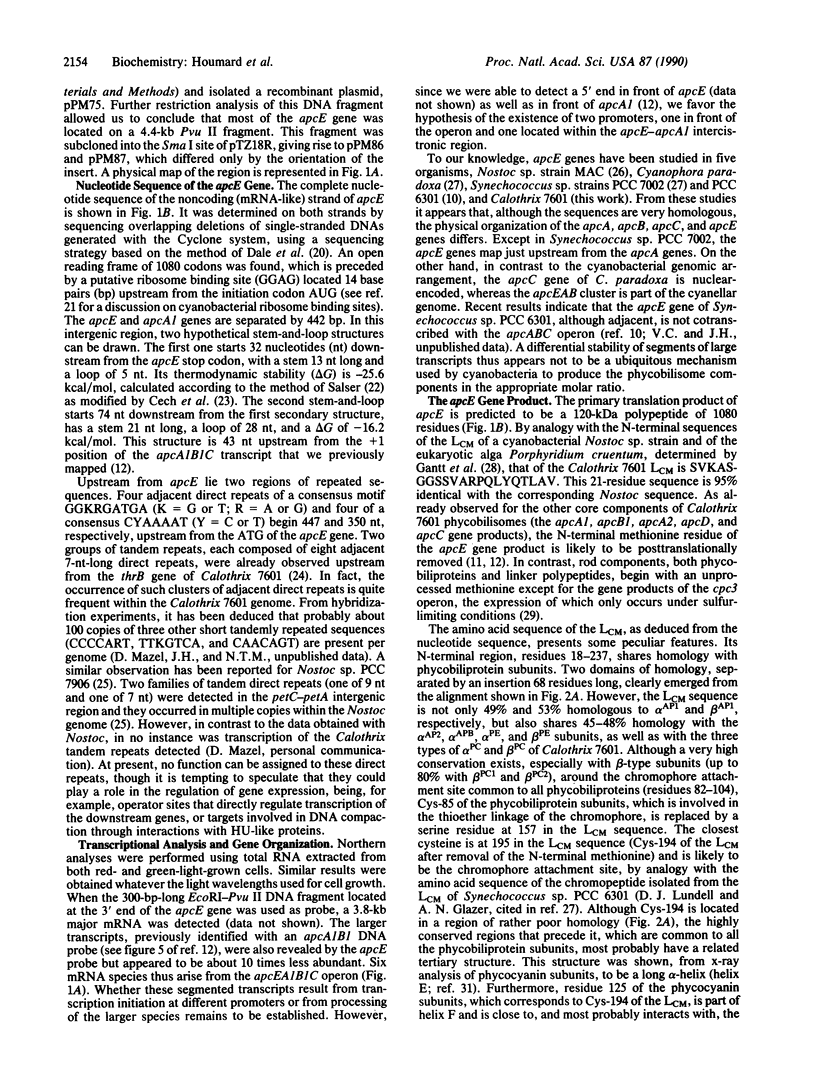
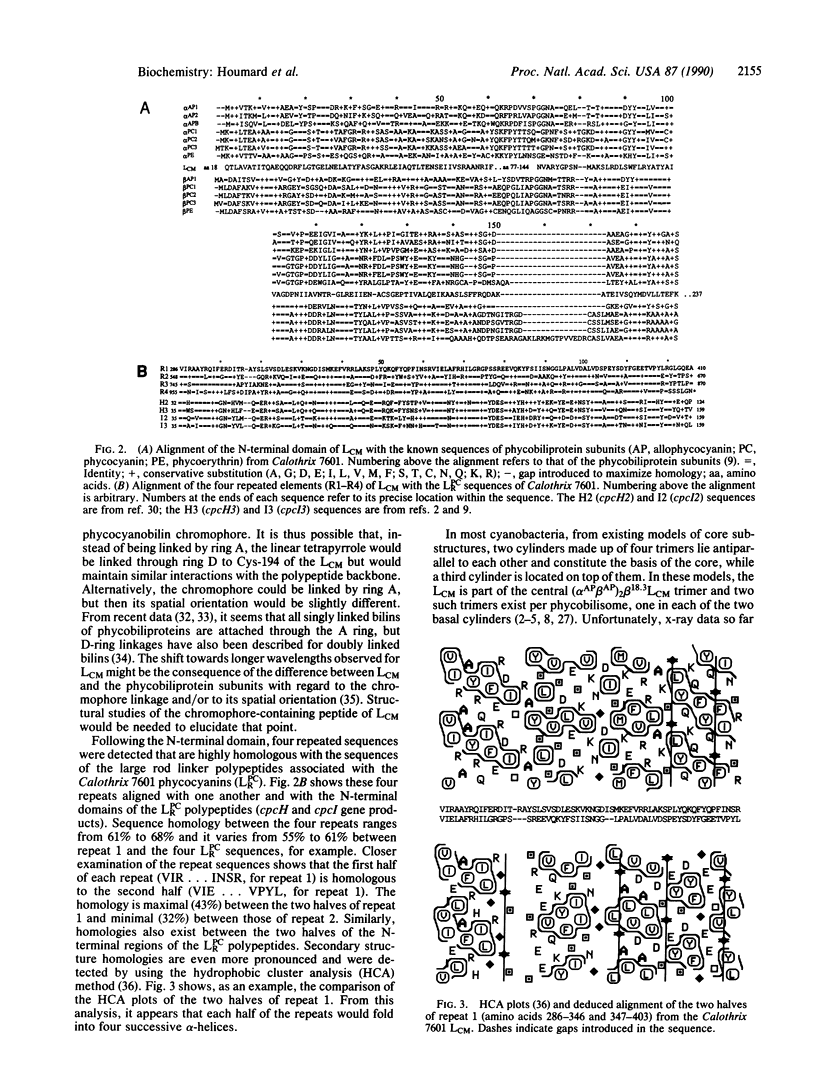
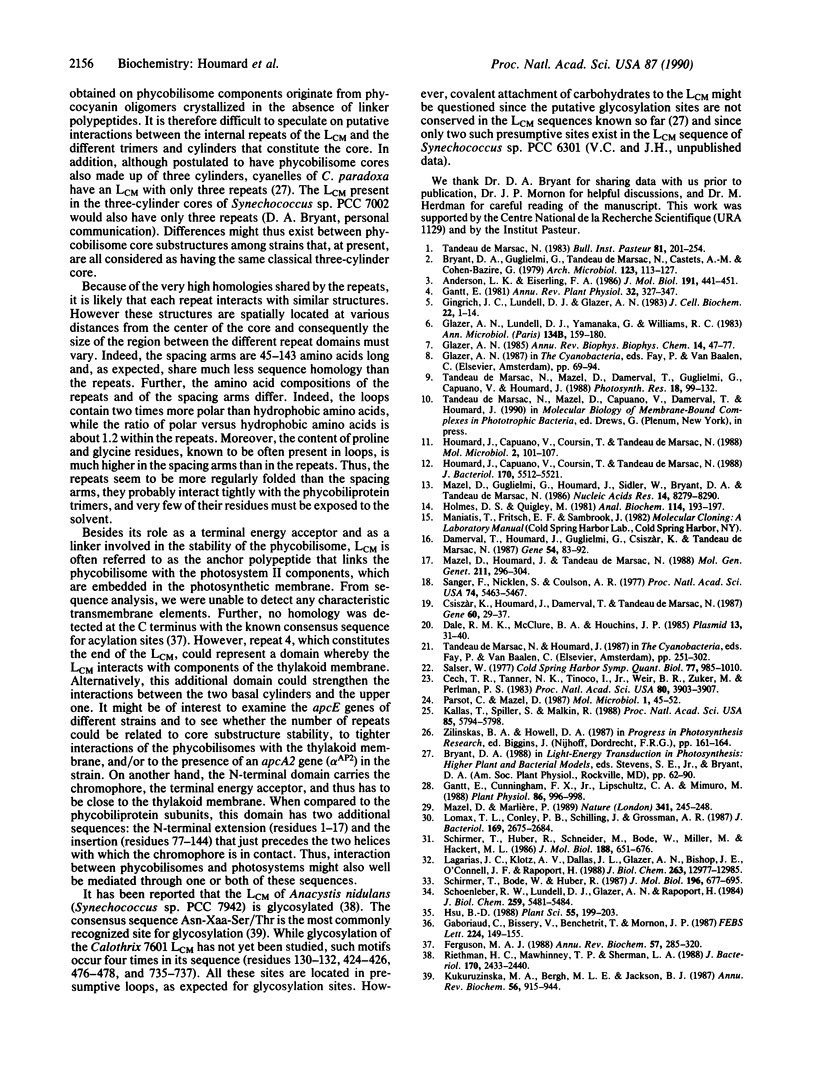
Selected References
These references are in PubMed. This may not be the complete list of references from this article.
- Anderson L. K., Eiserling F. A. Asymmetrical core structure in phycobilisomes of the cyanobacterium Synechocystis 6701. J Mol Biol. 1986 Oct 5;191(3):441–451. doi: 10.1016/0022-2836(86)90139-7. [DOI] [PubMed] [Google Scholar]
- Cech T. R., Tanner N. K., Tinoco I., Jr, Weir B. R., Zuker M., Perlman P. S. Secondary structure of the Tetrahymena ribosomal RNA intervening sequence: structural homology with fungal mitochondrial intervening sequences. Proc Natl Acad Sci U S A. 1983 Jul;80(13):3903–3907. doi: 10.1073/pnas.80.13.3903. [DOI] [PMC free article] [PubMed] [Google Scholar]
- Csiszàr K., Houmard J., Damerval T., Tandeau de Marsac N. Transcriptional analysis of the cyanobacterial gvpABC operon in differentiated cells: occurrence of an antisense RNA complementary to three overlapping transcripts. Gene. 1987;60(1):29–37. doi: 10.1016/0378-1119(87)90210-1. [DOI] [PubMed] [Google Scholar]
- Dale R. M., McClure B. A., Houchins J. P. A rapid single-stranded cloning strategy for producing a sequential series of overlapping clones for use in DNA sequencing: application to sequencing the corn mitochondrial 18 S rDNA. Plasmid. 1985 Jan;13(1):31–40. doi: 10.1016/0147-619x(85)90053-8. [DOI] [PubMed] [Google Scholar]
- Damerval T., Houmard J., Guglielmi G., Csiszar K., Tandeau de Marsac N. A developmentally regulated gvpABC operon is involved in the formation of gas vesicles in the cyanobacterium Calothrix 7601. Gene. 1987;54(1):83–92. doi: 10.1016/0378-1119(87)90350-7. [DOI] [PubMed] [Google Scholar]
- Ferguson M. A., Williams A. F. Cell-surface anchoring of proteins via glycosyl-phosphatidylinositol structures. Annu Rev Biochem. 1988;57:285–320. doi: 10.1146/annurev.bi.57.070188.001441. [DOI] [PubMed] [Google Scholar]
- Gaboriaud C., Bissery V., Benchetrit T., Mornon J. P. Hydrophobic cluster analysis: an efficient new way to compare and analyse amino acid sequences. FEBS Lett. 1987 Nov 16;224(1):149–155. doi: 10.1016/0014-5793(87)80439-8. [DOI] [PubMed] [Google Scholar]
- Gantt E., Cunningham F. X., Lipschultz C. A., Mimuro M. N-terminus conservation in the terminal pigment of phycobilisomes from a prokaryotic and eukaryotic alga. Plant Physiol. 1988 Apr;86(4):996–998. doi: 10.1104/pp.86.4.996. [DOI] [PMC free article] [PubMed] [Google Scholar]
- Gingrich J. C., Lundell D. J., Glazer A. N. Core substructure in cyanobacterial phycobilisomes. J Cell Biochem. 1983;22(1):1–14. doi: 10.1002/jcb.240220102. [DOI] [PubMed] [Google Scholar]
- Glazer A. N. Light harvesting by phycobilisomes. Annu Rev Biophys Biophys Chem. 1985;14:47–77. doi: 10.1146/annurev.bb.14.060185.000403. [DOI] [PubMed] [Google Scholar]
- Glazer A. N., Lundell D. J., Yamanaka G., Williams R. C. The structure of a "simple" phycobilisome. Ann Microbiol (Paris) 1983 Jul-Aug;134B(1):159–180. doi: 10.1016/s0769-2609(83)80103-3. [DOI] [PubMed] [Google Scholar]
- Holmes D. S., Quigley M. A rapid boiling method for the preparation of bacterial plasmids. Anal Biochem. 1981 Jun;114(1):193–197. doi: 10.1016/0003-2697(81)90473-5. [DOI] [PubMed] [Google Scholar]
- Houmard J., Capuano V., Coursin T., Tandean de Marsac N. Isolation and molecular characterization of the gene encoding allophycocyanin B, a terminal energy acceptor in cyanobacterial phycobilisomes. Mol Microbiol. 1988 Jan;2(1):101–107. [PubMed] [Google Scholar]
- Houmard J., Capuano V., Coursin T., Tandeau de Marsac N. Genes encoding core components of the phycobilisome in the cyanobacterium Calothrix sp. strain PCC 7601: occurrence of a multigene family. J Bacteriol. 1988 Dec;170(12):5512–5521. doi: 10.1128/jb.170.12.5512-5521.1988. [DOI] [PMC free article] [PubMed] [Google Scholar]
- Kallas T., Spiller S., Malkin R. Primary structure of cotranscribed genes encoding the Rieske Fe-S and cytochrome f proteins of the cyanobacterium Nostoc PCC 7906. Proc Natl Acad Sci U S A. 1988 Aug;85(16):5794–5798. doi: 10.1073/pnas.85.16.5794. [DOI] [PMC free article] [PubMed] [Google Scholar]
- Kukuruzinska M. A., Bergh M. L., Jackson B. J. Protein glycosylation in yeast. Annu Rev Biochem. 1987;56:915–944. doi: 10.1146/annurev.bi.56.070187.004411. [DOI] [PubMed] [Google Scholar]
- Lagarias J. C., Klotz A. V., Dallas J. L., Glazer A. N., Bishop J. E., O'Connell J. F., Rapoport H. Exclusive A-ring linkage for singly attached phycocyanobilins and phycoerythrobilins in phycobiliproteins. Absence of singly D-ring-linked bilins. J Biol Chem. 1988 Sep 15;263(26):12977–12985. [PubMed] [Google Scholar]
- Lee C. S., Hwang L. Y., Beasley R. P., Hsu H. C., Lee H. S., Lin T. Y. Prognostic significance of histologic findings in resected small hepatocellular carcinoma. Acta Chir Scand. 1988 Mar;154(3):199–203. [PubMed] [Google Scholar]
- Lomax T. L., Conley P. B., Schilling J., Grossman A. R. Isolation and characterization of light-regulated phycobilisome linker polypeptide genes and their transcription as a polycistronic mRNA. J Bacteriol. 1987 Jun;169(6):2675–2684. doi: 10.1128/jb.169.6.2675-2684.1987. [DOI] [PMC free article] [PubMed] [Google Scholar]
- Mazel D., Guglielmi G., Houmard J., Sidler W., Bryant D. A., Tandeau de Marsac N. Green light induces transcription of the phycoerythrin operon in the cyanobacterium Calothrix 7601. Nucleic Acids Res. 1986 Nov 11;14(21):8279–8290. doi: 10.1093/nar/14.21.8279. [DOI] [PMC free article] [PubMed] [Google Scholar]
- Mazel D., Marlière P. Adaptive eradication of methionine and cysteine from cyanobacterial light-harvesting proteins. Nature. 1989 Sep 21;341(6239):245–248. doi: 10.1038/341245a0. [DOI] [PubMed] [Google Scholar]
- Parsot C., Mazel D. Cloning and nucleotide sequence of the thrB gene from the cyanobacterium Calothrix PCC 7601. Mol Microbiol. 1987 Jul;1(1):45–52. doi: 10.1111/j.1365-2958.1987.tb00525.x. [DOI] [PubMed] [Google Scholar]
- Riethman H. C., Mawhinney T. P., Sherman L. A. Characterization of phycobilisome glycoproteins in the cyanobacterium Anacystis nidulans R2. J Bacteriol. 1988 Jun;170(6):2433–2440. doi: 10.1128/jb.170.6.2433-2440.1988. [DOI] [PMC free article] [PubMed] [Google Scholar]
- Sanger F., Nicklen S., Coulson A. R. DNA sequencing with chain-terminating inhibitors. Proc Natl Acad Sci U S A. 1977 Dec;74(12):5463–5467. doi: 10.1073/pnas.74.12.5463. [DOI] [PMC free article] [PubMed] [Google Scholar]
- Schirmer T., Bode W., Huber R. Refined three-dimensional structures of two cyanobacterial C-phycocyanins at 2.1 and 2.5 A resolution. A common principle of phycobilin-protein interaction. J Mol Biol. 1987 Aug 5;196(3):677–695. doi: 10.1016/0022-2836(87)90040-4. [DOI] [PubMed] [Google Scholar]
- Schirmer T., Huber R., Schneider M., Bode W., Miller M., Hackert M. L. Crystal structure analysis and refinement at 2.5 A of hexameric C-phycocyanin from the cyanobacterium Agmenellum quadruplicatum. The molecular model and its implications for light-harvesting. J Mol Biol. 1986 Apr 20;188(4):651–676. doi: 10.1016/s0022-2836(86)80013-4. [DOI] [PubMed] [Google Scholar]
- Schoenleber R. W., Lundell D. J., Glazer A. N., Rapoport H. Bilin attachment sites in the alpha and beta subunits of B-phycoerythrin. Structural studies on a doubly peptide-linked phycoerythrobilin. J Biol Chem. 1984 May 10;259(9):5481–5484. [PubMed] [Google Scholar]


